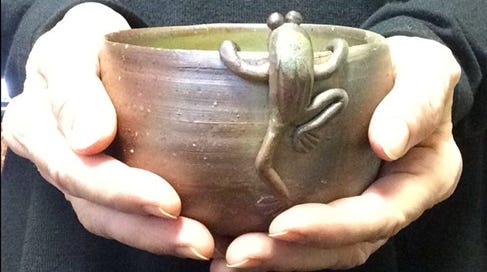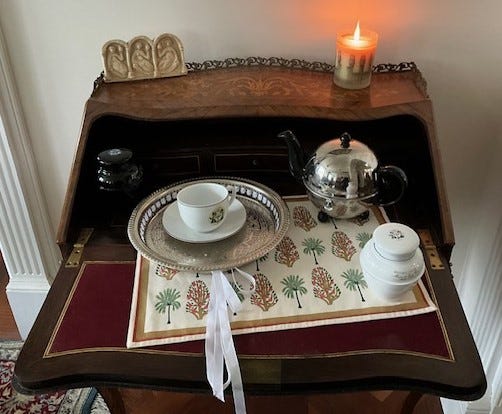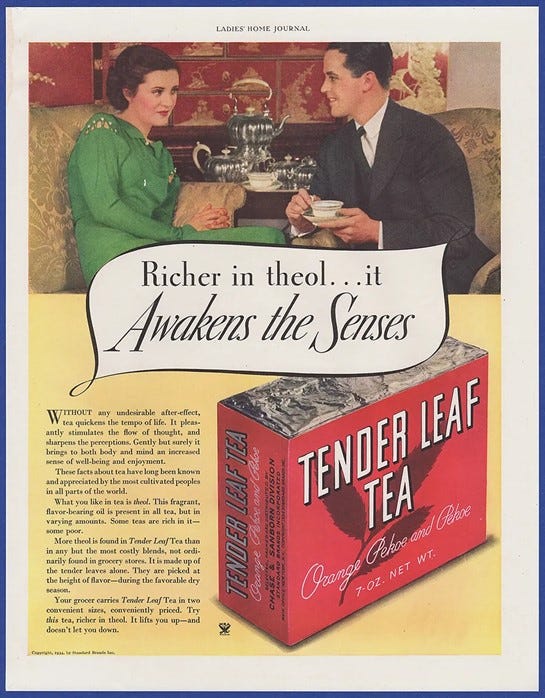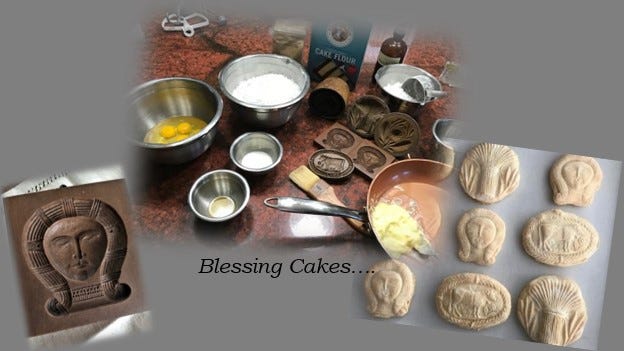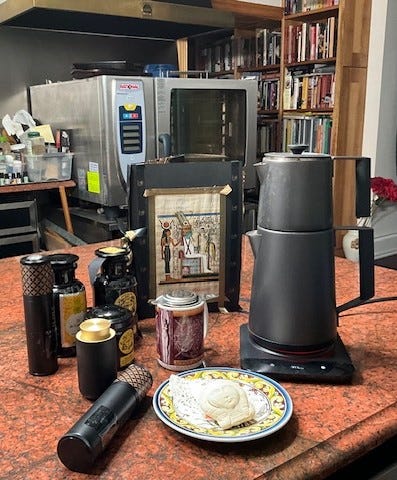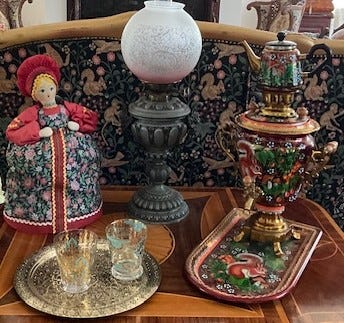My favorite matcha tea bowl.
While volumes of tea books occupy several shelves in my kitchen library, in the end, none of these books deliver the joy I experience when I enter the sanctuary of tea. My tea ritual, not dictated by distant traditions, but led by an intuitive union with Camellia sinensis, the tea plant of many natures, sends me on a journey of discovery, traveling the tea road of infinite offerings. I savor every moment, following the path of a poem from the Tang Dynasty of about 900 BC.
Song of Seven Cups The first cup caresses my dry lips and throat. The second shatters the walls of my lonely sadness. The third searches the dry rivulets of my soul to find the stories of five thousand scrolls. With the fourth the pain of life’s grievances evaporates through my pores. The fifth relaxes my muscles and bones become light. With the sixth I find the path that leads to the immortal ancestors. Oh, the seventh cup! Better not take it! If I had it the only feeling Is the fresh wind blowing through my wings. Lú Tóng, Táng Dynasty
A tea offering before the roaring fire.
Tea, mercurial in nature, sharing and shifting along with our needs and moods. Calming, soothing, stimulating, celebrating, consoling, steadfast companion as we journey daily, navigating over large and small mountains, shallow and deep valleys, and in between, relaxing in quiet moments of contemplation. Tea accompanies us through it all. Far more than the sum of its calculated chemical ingredients, tea supports us through the ever drifting moments of each day. Enjoyed at home, in the office, and on the road, tea is the second most consumed beverage in the world, only surpassed by water.
The cultivation of tea reflects many factors requiring work and skill. The landr, soil, climate, altitude, and latitude are just a few, resulting in the production of black, green, white, yellow, and blue tea.
We can read about tea’s history, botany, and variety of landscapes and fermenting practices. We can learn about successfully pairing it with food and dessert. We can study and benefit from its medicinal advantages. Yet true tea appreciation begins with an intimate meeting. We move beyond a page of writing to meet tea in person, inhaling the special energies that create a meaningful bond. We choose the time and place, feeling our way. We begin simply, and little by little our palate seeks more sophistication, the yearning increasing to expand our relationship with the complex personalities of the varieties of amazing Camellia sinensis. A single cup begins the journey, nudging us to befriend other varieties, each suitable for different moods in our ever-shifting life, opening us to experiment with our preparation and our tea tools, enhancing our experience. We can travel the world in search of treasured varieties. We can seek its company at dawn and dusk and anytime between. Our meeting may be simple and solitary or elaborate, shared with friends.
My quiet tea corner.
As visitors to my home quickly learn, tea is not the simple dunking of the ignoble tea bag into the cup. Tea is an honored guest at my table. My tea collection fills closets, rivaling most tea establishments. The exquisite tea caddies, indigo bottles with glass ground tops, hand molded matcha bowls, whisks delighting the pastry chef in me, sit alongside porcelain and iron tea pots. The collection is ever expanding with my unending thirst to embrace the world of tea varieties and tools. After tending to necessary responsibilities such as taxes, my remaining funds goes to books and tea. My ideal home is a library with an adjacent chef’s kitchen featuring a bed in a corner by the stoves to warm me on a cold winter’s night. Cinderella of dreams, reading with a cup of tea by my side.
My love for tea and books had humble beginnings. Growing up, I did not know of the great world of tea beyond the little tea bags that sat in the red supermarket cardboard box in my childhood cupboard.
Tender Leaf Tea, 1930’s advertisement.
My mother loved tea and yet her brew was a weak cup of Tender Leaf orange pekoe. She drank it without adding sugar or milk, sweetness always supplied by a light dessert, a homemade cookie, or a slice cake. As mother was for me the most beautiful, talented model of perfection I could ever know or love, I followed her in all things. I purchased the brand she loved, preparing and drinking it in the very same manner as she. For years, it was my simple routine, a treasured tradition. I poured boiling water over an unending supply of supermarket tea bags, quickly removing each upon seeing the desired pale amber color that my mother, the artist, had deemed the standard upon which all tea was measured. Tea moments were filled with memories of my mother. I would see her perfectly sculptured fingers curled around the teacup as she enjoyed her tea with dessert. At the tender age when most children were outside skipping rope and riding bicycles, I was inside, watching her paint, cook, bake, and in the end, enjoy her daily cups of tea. Hers was the alchemical kitchen in which I apprenticed. By the time I was nine years old I was baking treats to accompany our tea. While mother enjoyed cooking and was an excellent cook, baking took precious time away from her painting and was for her a rushed process hastily aimed at satisfying her sweet tooth. I, on the other hand, while happy to help with the cooking, was completely smitten with the process of creating dessert masterpieces. I eagerly released her of baking duties. My spare time was spent happily experimenting with recipes. I became the pastry chef, providing desserts not only for our family meals, but also for the guests enjoying mother’s dinner parties. Thus, tea was always accompanied by festive cakes and a variety of sugar cookies. While experimenting with my baking, I never considered wandering from mother’s tea ritual.
My passionate baking adventures resulted in my producing Blessing Cakes, sweet accompaniments to enjoy with tea….(You will find the recipe in the second half of this post)
Mother’s tea ritual possibly would have held fast to what I saw as a beloved tradition had it not been for my desire to share tea with a colleague as I labored in the hospital laboratory during my doctoral internship. My colleague was Dr. Christina, a brilliant doctor who immigrated to the United States from Russia. It was she who instructed me on the importance of making a proper cup of tea, something that would be the beginning of a lifetime passion.
One day in the lab, she frowned at my offerings of a very weak cup of tea, made from a tea bag. Immediately she threw the tea down the lab sink and demanded we begin anew. She went on to teach me how to prepare a proper cup of tea, even if we did not have a traditional Russian samovar, which she described in detail, as consisting of two vessels, a large metal lower container containing boiling water, featuring a small sprout on its lower portion, and a small tea pot sitting on top of it holding strongly brewed tea. She pointed out my supermarket tea bag contained mere fannings, small pieces of broken leaves, left behind after the higher grades were gathered for sale. I noted her instruction, never realizing that this was the beginning of my travels along my personal tea road, following a long caravan of tea purveyors.
An electric samovar, the sleek modern answer to making beautiful tea, the kitchen tea and culinary library behind the combi-cooker. .
That day we prepared tea using beakers and Bunsen burners. We lit them, filled two glass beakers with distilled water, and put each on a burner. We placed a glass plate on each, and while we waited for the water to boil, we washed other beakers and filled each with piping hot tap water. One would be our beaker tea pot, the others would serve as our teacups. We set them aside and watched as the water began to boil. We turned off the flames. Dr Christina emptied the tap water from our makeshift tea pot, tore open two tea bags, and emptied the fannings into it, before gently pouring the quiescent boiled water over the tea. I watched the water turn pale amber before darkening considerably, far more than I believed I would ever like. I was dead wrong. She filled our cups, half full with the strong tea topped off by boiled water. I was amazed at the difference in the tea. Poor quality or not, the tea tasted incredibly richer, its flavors more rounded. I smiled. She then assembled our laboratory samovar, placing our tea filled beaker atop the remaining heated water beaker. Thus, I had my first real cup of properly prepared tea. If a simple supermarket tea could be elevated by the manner of preparation, I could only imagine the joys awaiting my pilgrimage along the tea road of discovery.
Hand-painted samovar with charming tea cozy, gift, from Russian with love.
The tea of my childhood will always remain a cherished memory, yet a new appreciation for tea was bursting within me, stirring my imagination and igniting a desire to know more intimately this humble beverage. My lifetime love affair with tea began that day.
Keep reading with a 7-day free trial
Subscribe to Sanctuary of Alchemical Feasts to keep reading this post and get 7 days of free access to the full post archives.

